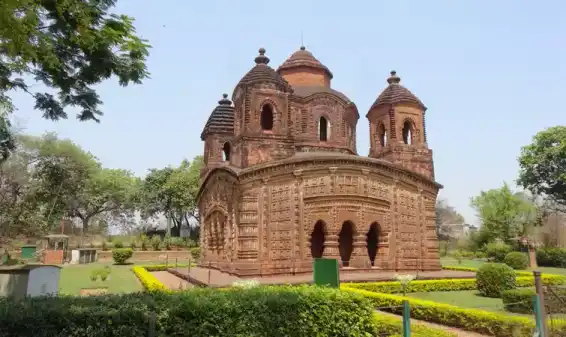A Comprehensive Overview of Bishnupur District
Introduction
Bishnupur, located in the Indian state of West Bengal, is a district renowned for its rich cultural heritage, historical significance, and natural beauty. This article provides an in-depth look at Bishnupur's demography, culture, geography, topography, cuisine, history, notable poets and authors, and administrative structure.
Demography
Bishnupur's population is a mosaic of various communities and cultures. According to the latest census, the district has a population of approximately 1.2 million people. The major ethnic groups include Bengalis, with significant communities of Adivasis, particularly the Santhal tribe. Hinduism is the predominant religion, followed by Islam and Christianity. The literacy rate in Bishnupur is relatively high, reflecting the district's emphasis on education and cultural development.
Culture
Traditional Arts and Crafts
Bishnupur is synonymous with its terracotta temples and exquisite Baluchari sarees. The district is a hub for traditional crafts such as pottery, weaving, and silk production. The terracotta temples, built during the reign of the Malla kings, are architectural marvels adorned with intricate carvings depicting scenes from Hindu epics.
Festivals and Music
Festivals in Bishnupur are vibrant and reflect the cultural diversity of the region. The Bishnupur Mela, held annually, showcases local crafts, music, and dance. Classical music is an integral part of the cultural fabric, with Bishnupur Gharana being a prominent school of Indian classical music known for its Dhrupad style.
Geography and Topography
Location and Climate
Bishnupur is situated in the Bankura district of West Bengal, encompassing an area of approximately 3,640 square kilometers. The district experiences a tropical climate with hot summers, monsoon rains, and mild winters. The region's fertile land is nourished by rivers such as the Damodar and Dwarakeswar, which play a crucial role in the agricultural economy.
Natural Resources and Flora and Fauna
The district is rich in natural resources, including clay, which is vital for the terracotta industry. The landscape is dotted with lush forests, home to diverse flora and fauna. Sal, teak, and bamboo are common tree species, while the forests provide habitat for animals like deer, wild boar, and various bird species.
Cuisines
Traditional Dishes
Bishnupur's cuisine is a delightful blend of Bengali culinary traditions and tribal influences. Rice and fish form the staple diet, with dishes such as Macher Jhol (fish curry) and Panta Bhat (fermented rice) being local favorites. The district is also known for its sweet delicacies like Pithe, Sandesh, and the iconic Bengali Rosogolla.
Unique Culinary Practices
The use of locally sourced ingredients and traditional cooking methods, such as cooking in earthen pots, adds a unique flavor to the cuisine. The influence of tribal culinary practices is evident in the use of forest produce and rustic cooking techniques.
History
Ancient and Medieval Periods
Bishnupur's history dates back to ancient times, with evidence of human habitation since the prehistoric period. The district gained prominence during the reign of the Malla dynasty, which ruled from the 7th to the 18th century. The Malla kings were great patrons of art and culture, leading to the construction of the famous terracotta temples.
Colonial Era and Independence
During the British colonial period, Bishnupur was part of the larger administrative region of Bankura. The district played a role in the struggle for independence, with local leaders and activists contributing to the freedom movement. Post-independence, Bishnupur emerged as a separate administrative district, focusing on preserving its cultural heritage while pursuing developmental goals.
Notable Poets and Authors
Jnanadanandini Devi
One of the most celebrated literary figures from Bishnupur is Jnanadanandini Devi, known for her contributions to Bengali literature and women's empowerment. Her writings reflect the socio-cultural milieu of her time and continue to inspire generations.
Bishnu Dey
Another prominent figure is Bishnu Dey, a poet, and critic whose works are celebrated for their lyrical beauty and profound philosophical insights. His poetry often draws inspiration from the rich cultural and historical heritage of Bishnupur.
Administration
Administrative Structure
Bishnupur district is divided into several administrative units, including subdivisions, blocks, and panchayats. The district administration is headed by a District Magistrate, who oversees various departments such as revenue, education, health, and law enforcement.
Development Initiatives
The district administration has been proactive in implementing development programs focusing on infrastructure, education, healthcare, and tourism. Efforts are being made to promote Bishnupur as a cultural and heritage tourism destination, leveraging its historical and cultural assets.
Suggested Diagram
Conclusion
Bishnupur district stands as a testament to the rich cultural heritage and historical legacy of West Bengal. From its intricate terracotta temples and vibrant festivals to its delicious cuisine and literary contributions, Bishnupur offers a fascinating glimpse into the past and present. As the district continues to develop, it remains committed to preserving its unique identity and cultural wealth for future generations.
